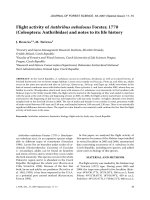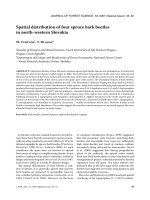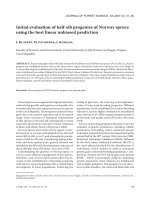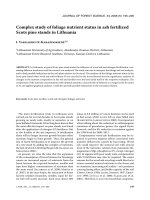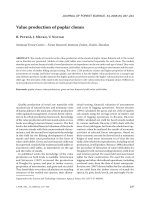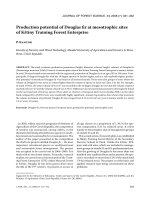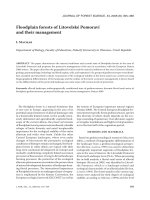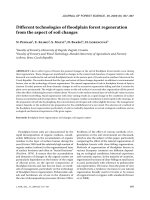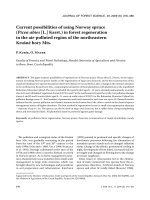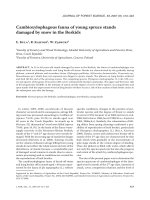Báo cáo lâm nghiệp: "Element analysis of tree rings in pedunculate oak heartwood: an indicator of historical trends in the soil chemistry, related to atmospheric deposition" ppsx
Bạn đang xem bản rút gọn của tài liệu. Xem và tải ngay bản đầy đủ của tài liệu tại đây (747.02 KB, 12 trang )
Original
article
Element
analysis
of
tree
rings
in
pedunculate
oak
heartwood:
an
indicator
of
historical
trends
in
the
soil
chemistry,
related
to
atmospheric
deposition
G
Lévy,
C
Bréchet,
M
Becker
Unité
d’écophysiologie
forestière,
Centre
de
Nancy,
Inra,
54280
Champenoux,
France
(Received
1
September
1994;
accepted
15
November
1995)
Summary —
When
investigating
historical
alterations
of
the
soil
chemistry,
it
could
be
interesting
to
determine
the
mineral
content
of
the
successive
annual
tree
rings.
The
study
reported
here
aimed
at
verifying
this
assumption.
Oak
heartwood
was
selected
in
order
to
minimize
the
disturbance
due
to
ele-
ment
translocations
in
the
wood.
This
study
was
carried
out
in
a
forest
included
in
a
floristic
and
eda-
phic
survey
performed
earlier
throughout
northeast
France.
Xylem
cores
were
extracted
from
the
boles
of
five
over
60-year-old
pedunculate
oaks
in
each
of
68
plots.
The
analysis
showed
on
average
an
increase
in
nitrogen
and
aluminum,
a
decrease
in
phosphorus,
potassium
and
magnesium,
and
no
change
for
calcium,
in
the
rings
corresponding
to
the
last
30
years
of
the
heartwood
(1938-1967).
These
results
are
consistent
with
those
of
the
floristic
and
edaphic
survey,
which
had
shown
an
increase
in
nitrogen
and
a
trend
towards
acidification
in
most
of
the
soils
between
1970
and
1990,
mainly
due
to
atmospheric
deposition
(Thimonier
et
al,
1992).
Thus,
these
changes
in
the
soil
chemistry
had
probably
already
affected
the
forest
studied
between
1938
and
1967.
Finally,
tree-ring
analysis
of
oak
heartwood
appeared
to
be
an
effective
approach
to
reveal
historical
changes
in
forest
soil
chemistry.
tree
ring
/
pedunculate
oak
/
heartwood
/
soil
chemistry
/
atmospheric
deposition
Résumé —
Analyse
minérale
des
cernes
annuels
du
bois
de
cœur
de
chêne
pédonculé ;
un
outil
de
détection
de
changements
intervenus
dans
les
propriétés
du
sol,
en
relation
avec
les
dépôts
atmosphériques.
L’étude
porte
sur
l’intérêt
potentiel
de
l’analyse
des
cernes
successifs
du
bois
pour
appréhender
l’évolution
dans
le
temps
des
propriétés
du
sol.
Le
choix
du
bois
de
cœur
de
chêne
pédonculé
pour
cette
étude
devrait permettre
de
minimiser
les
effets
perturbateurs
des
translocations
d’éléments
à
l’intérieur
du
bois.
L’étude
a
été
réalisée
dans
une
forêt
incluse
dans
une
enquête
floristique
et
édaphique
réalisée
précédemment
dans
le
nord-est
de
la
France
(Thimonier
et
al,
1992).
Des
«carottes»
de
bois
ont
été
extraites
du
tronc
de
cinq
chênes
pédonculés
âgés
de
plus
de
60
ans
dans
chacun
des
68 placeaux
retenus.
L’analyse
a
montré
en
moyenne
une
augmentation
de
l’azote
et
de
l’aluminium,
une
diminution
du
phosphore,
du
potassium
et
du
magnésium,
et
aucune
tendance
pour
le
calcium,
dans
les
cernes
correspondant
aux
30
dernières
années
du
bois
de
cœur
(de
1938
à
1967).
Ces
résultats
sont
cohérents
avec ceux
de
l’étude
floristique
et
édaphique,
qui
avait
montré
que
la
plupart
des
sols
concernés
avaient
subi
entre
1970
et
1990
un
enrichissement
en
azote
et
une
ten-
dance
vers
l’acidification,
essentiellement
à
la
suite
de
dépôts
d’origine
atmosphérique.
Il
est
donc
pro-
bable
que
cette
évolution
des
propriétés
du
sol
ait
déjà
affecté
la
forêt
étudiée
entre
1938
et
1967.
Il
apparaît
ainsi
que
l’analyse
des
cernes
annuels
de
bois
de
cœur
de
chêne
pédonculé
pourrait
consti-
tuer
une
approche
intéressante
pour
révéler
des
changements
intervenus
dans
le
passé
au
niveau
des
propriétés
chimiques
du
sol.
cerne
annuel / chêne
pédonculé / bois
de
cœur / chimie
du
sol / dépôt atmosphérique
INTRODUCTION
It
is
generally
accepted
that
the mineral
con-
tent
of
a
tree
stemwood
partly
depends
on
the
chemical
composition
of
xylem
sap
(Bondietti
and
Shortle,
1990).
The
element
concentration
of
each
tree
ring
may
there-
fore,
to
a
certain
extent,
reflect
the
properties
which
characterized
the
soil
during
the
year
when
this
ring
was
formed
(Bondietti
and
McLaughlin,
1992).
That
is
the
reason
why
tree-ring
analysis
has
been
used
for
sev-
eral
years
to
investigate
historical
changes
which
occurred
in
soil
chemistry.
This
approach
could
be
of
great
interest
as
other
methods
like soil
analyses
or
floristic
sur-
veys
do
not
generally
enable
us
to
go
back
very
far
in
the
past.
Soil
analyses
would
require
repeated
sampling
at
exactly
the
same
place
at
a
pace
of
several
decades
and
exactly
the
same
analytical
procedures
to
be
used.
Tree-ring
analysis
proved
to
be
more
or
less
in
accordance
with
historical
events
involving
the
soil,
including:
i)
con-
tamination
of
the
environment
by
different
elements,
in
particular
Cu,
Pb, Zn,
Mn,
Al,
Fe,
B,
Ni,
Cd,
generally
coming
from
indus-
trial
areas,
coal-burning
power
generators
or
vehicle
exhaust
fumes.
Species
involved
were
conifers
(Robitaille,
1981;
Baes
and
McLaughlin,
1984;
Guyette
and
McGinnes,
1987;
Guyette
et
al,
1991;
Zayed
et
al,
1992)
as
well
as
broadleaved
species
(Vroblesky
and
Yanosky,
1990;
Stewart
et
al,
1991)
including
oaks
(Herrmann
et
al,
1978;
Kardell
and
Larsson,
1978;
Queirolo
et
al,
1990;
Yanosky
and
Vroblesky,
1992);
ii)
fer-
tilization
(McClenahen
et al,
1989;
Kashuba,
1992); iii)
acidification
of
the
soil,
generally
ascribed
to
atmospheric
deposition
(Meisch
et
al,
1986;
Arp
and
Manasc,
1988;
Rags-
dale
and
Berish,
1988;
Scherbatskoy
and
Matusiewicz,
1988;
Bondietti
et
al,
1989;
Bondietti
and
McLaughlin,
1992).
However,
results of
the
different
studies
were
not
always
clear
nor
consistent
with
one
another,
and
interpreting
tree-ring
anal-
ysis
often
proved
to
be
a
complicated
task.
The
main
reason
is
the
widespread
occur-
rence
of
radial
and
vertical
translocation
of
elements,
which
alters
the mineral
content
of
annual
rings
to
varying
degrees.
Some
ele-
ments
are
more
susceptible
to
transloca-
tion
than
others
(McClenahen
et
al,
1989;
Kairiukstis
and
Kocharov,
1990),
including
in
some
cases
redistributions
associated
with
the
transformation
of
sapwood
to
heartwood
(Okada
et
al,
1988;
Frelich
et
al,
1989;
De
Visser,
1992).
Some
macronutrients
are
often
partly
remobilized
from
older
annual
rings
and
transferred
towards
younger
and
more
active
parts
of
the
wood
(Ogner
and
Bjor,
1988;
Häsänen
and
Huttunen,
1989;
Peterson
and
Anderson,
1990;
Chun
and
Hui-yi,
1992;
De
Visser,
1992).
Translocation
mainly
affects
the
sapwood,
and
therefore
the
mineral
content
of
a
given
ring
is
likely
to
vary
with
time
as
long
as
it
is
part
of
the
sapwood.
Translocation
may
also
concern
the
heartwood
(Wardell
and
Hart,
1973),
but
generally
on
a
much
smaller
scale,
except
for
some
elements
absorbed
in
excess
in
contaminated
areas
that
may
be
transferred
to
the
heartwood
through
a
detoxication
process
(Trüby,
1988;
Long
and
Davis,
1989;
Kairiukstis
and
Kocharov,
1990;
Vroblesky
et
al,
1992).
Translocation
may
also
depend
on
the
species
under
study
(Guyette
et
al,
1992).
In
particular,
each
ring
is
used
for
sap
transport
during
a
variable
number
of
years:
so,
the
initial
min-
eral
content
of
a
given
ring
may
be
altered
over
a
long
period
after
its
formation,
by
cation
exchange
processes
with
the
xylem
sap
(Arp,
1988;
Arp
and
Manasc,
1988;
Bondietti
et
al,
1989;
Bondietti
and
Shortle,
1990;
Bondietti
et
al,
1990;
Bondietti
and
McLaughlin,
1992;
McClenahen
and
Vim-
merstedt,
1993).
For
those
reasons,
it could
be
interesting,
in
particular
when
investi-
gating
macronutrients,
i)
to
pay
special
atten-
tion
to
the
mineral
content
of
the
rings
in
the
heartwood;
ii)
to
work
on
oaks,
which
are
ring-porous
species
in
which
sap
is
mainly
transported
in
the
current
year
or
last
2-
or
3-year-old
vessels
(Hinckley
and
Las-
soie,
1981;
Hagemeyer et al,
1992;
Granier
et
al,
1994),
even
though
the
wood
struc-
ture
of
broadleaved
species
is
more
likely
to
allow
lateral
transfer
than
that
of
conifers
(Zayed
et
al,
1992).
We
therefore
carried
out
a
study
to
test
tree-ring
analysis
on
the
heartwood
of
pedunculate
oak
as
an
indi-
cator
of
temporal
trends
in
some
chemical
properties
of
the
soil.
We
worked
in
a
forest
included
in
a
floris-
tic
survey
performed
earlier
in
forest
ecosys-
tems
located
throughout
northeast
France.
This
survey,
completed
with
soil
analyses
in
some
of
the
forests
studied,
showed
a
widespread
enrichment
of
the
soils
in
nitro-
gen
between
1970
and
1990
(Thimonier,
1994);
in
addition,
it
revealed
a
trend
towards
a
more
acidic
state
for
a
large
number
of
the
soils
during
the
same
period.
We
exam-
ined
the
two
approaches -
tree-ring
analy-
sis
and
floristic
survey -
to
see
if
the
results
were
consistent
with
each
other,
and
to
test
the
interest
of
tree-ring
analysis.
METHODS
We
selected
the
Amance
State
Forest,
about
1
000
ha,
in
the
Lorraine
plain,
15
km
northeast
of
Nancy,
in
the
northeast
of
France.
This
forest
is
subjected
to
a
semicontinental
climate,
with
an
average
annual
rainfall
of
700
mm.
It
stands
on
dif-
ferent
formations
of
the
Lias.
The
substrate
fre-
quently
consists
of
marl,
in
some
places
lime-
stone,
but
rarely
of
sandstone,
and
it
is
generally
covered
with
a
variable
thickness
of
silt
of
eolian
origin.
The
full
range
of
soil
types
in
the
Amance
Forest
is
fairly
large,
but
many
of
the
soils
are
mottled
leached
brown,
fairly
rich
in
nutrients,
with
a
mesotrophic
mull
and
a
pH
in
A1
(measured
in
water)
often
close
to
5.0.
They
frequently
display
a
temporary
water
table
which,
however,
may
rise
to
the
soil
surface
only
in
a
very
few
places.
Table
I
gives
the
chemical
analysis
of
one
of
these
mot-
tled
leached
brown
soils,
in
which
properties
are
roughly
intermediate
between
those
of
the
poor-
est
and
the
richest
soils
present
in
this
forest
(Morel,
1973).
Almost
all
the
stands
are
com-
posed
mainly
of
pedunculate
(Quercus
robur
L)
and
sessile
(Quercus
petraea
(Matt)
Liebl)
oaks,
often
mixed.
From
the
19th
century,
the
stands
have
been
changing
from
coppice
with
standards
to
high
forest;
this
conversion
was
more
or
less
completed,
depending
on
the
plots.
Five
pedunculate
oaks
over
60
years
old
were
selected
in
the
dominant
or
codominant
classes
from
each
of
68
plots
representative
of
the
envi-
ronmental
variability
in
this
forest.
Early
in
1988,
one
xylem
core
was
extracted
at
2.80
m
above
the
ground
from
the
southern
side
of
each
tree
bole,
with
a
5-mm
diameter
teflon-coated
incre-
ment
borer.
The
cores
were
stored
in
a
refrigerator
in
closed
plastic
tubes.
The
different
increments
of
each
core
were
dated
according
to
a
proce-
dure
described
by
Becker
et
al
(1994),
using
a
moving
graphic
program
after
the
progressive
detection
of
so-called
pointer
years.
The
surface
of
each
core
was
decontaminated
by
sticking
a
piece
of
adhesive
tape
onto
it,
and
then
removing
it.
The
glue
of
this
tape,
when
analyzed
in
our
laboratory,
was
free
of
the
elements
to
be
deter-
mined.
The
different
annual
increments
of
each
core
were
separated,
under
a
magnifying
glass,
with
a
ZrO
2
ceramic
blade
in
order
to
avoid
any
mineral
contamination.
Most
authors
investigating
tree-ring
analysis
use
several-year
increments;
in
order
to
collect
more
detailed
data,
we
worked
on
annual
increments,
some
of
them
as
narrow
as
0.8
mm.
The
last
annual
increment
(1987)
was
removed,
because
it
might
have been
contami-
nated
by
the
bark,
whose
mineral
content
is
often
much
higher
than
that
of
the
xylem.
All
the
incre-
ments
formed
a
given
year
in
all
68
plots
were
combined.
Thus,
we
obtained
49
annual
sam-
ples,
from
1938
to
1986,
which
were
oven-dried
at
65
°C
for
24
h.
Each
of
these
samples
was
weighed.
One
part
(about
1.5
g)
was
oven-ashed
at
500
°C;
ashes
were
processed
according
to
the
method
described
by
Pinta
(1973),
then
ana-
lyzed
for
the
macronutrients
P, K,
Ca,
Mg
and
for
Al,
an
element
which
is
linked
to
acidity
in
the
soil,
by
inductively
coupled
plasma
spectrome-
try
(ICP-AES),
and
an
ultrasonic
nebulisor when
elemental
concentrations
were
particularly
low
(Clément
et
al,
1994).
Another
part
(about
0.5
g)
of
each
sample
was
analyzed
for
N
by
a
seg-
mented
continuous
flow
analyser
at
630
nm,
after
Kjeldahl
digestion
in
the
presence
of
a
K2
SO
4
and
Se
catalyzer.
Temporal
trends
of
the
stemwood
mineral
con-
tents
were
analyzed
by
considering
the
signifi-
cance
of
the
linear
correlation
coefficients,
which
were
virtually
always
higher
than
the
nonlinear
ones.
RESULTS
A
visual
examination
of
the
cores
showed
that
the
sapwood-heartwood
boundary
was
located
on
average
between
the
1967
and
1968
increments.
The
mineral
content
of the
sapwood
In
addition
to
fluctuations
from
one
year
to
the
next,
the
overall
variation
of
the
element
concentration
across
the
sapwood
(ie,
from
1968
to
1986)
showed
different
patterns
(fig
1).
Potassium
was
the
only
element
in
which
variation
was
nonlinear
(polynomial
func-
tion).
The
linear
correlation
coefficients
were
positive
and
significant
at
the
1‰
level
for
the
other
macronutrients,
but
not
for
alu-
minum.
The
heartwood
mineral
content
Figure
2
shows
the
variations
in
the
ele-
ments
analyzed
from
the
heartwood
between
1938
and
1967
(30
years).
All
long-
term
variations
were
linear.
Three
patterns
may
be
distinguished:
an
increase
in
nitro-
gen
and
aluminum;
no
trend
for
calcium;
and
a
decrease
in
phosphorus,
potassium
and
magnesium.
The
correlation
coefficients
were
significant
at
the
5%
level
for
nitrogen
and
at
the
1‰
level
for
aluminum,
phos-
phorus,
potassium
and
magnesium.
DISCUSSION
AND
CONCLUSION
There
were
large
fluctuations
in
the
con-
centration
from
one
annual
ring
to
the
next,
both
in
sapwood
and
heartwood,
for
all
the
elements
analyzed.
These
fluctuations
were
probably
directly
related
to
interannual
changes
of
climatic
conditions
and/or
of
ring
width,
the
latter
change
altering
the
relative
proportions
of
earlywood
and
latewood
in
oak.
We
are
not
able
to
go
further
with
this
for
the
moment.
The
sharp
overall
increase
of
most
of
the
macronutrients
(N,
P,
Ca,
Mg)
across
the
sapwood
from
1968
to
1986
could
be
explained
in
two
different
ways:
it
might
reflect
an
increase
in
these
elements
in
the
soil
from
1968
to
1986,
or
it
might
be
a
con-
sequence
of
their
translocation
in
the
tree.
The
first
assumption
is
not
in
accordance
with
Thimonier
(1994),
who
detected
a
slight
decrease
in
nutrients
in
the
soil
from
1970
to
1990
throughout
northeast
France,
except
for
N.
On
the
other
hand,
many
authors
have
shown
that
macronutrients
are
often
trans-
ferred
from
older
rings
of
the
sapwood
to
younger
and
more
active
parts
of
the
tree
(see
Introduction).
Thus,
the
second
assumption
is
likely
to
be
right,
and
suc-
cessive
annual
losses
of
elements
through
translocations
inside
the
tree
would
proba-
bly
conceal
the
effects
on
the
ring
mineral
content
of
possible
temporal
decrease
of
their
concentration
in
the
soil.
Even
if
the
mineral
content
of
the
last
ring
depends
on
the
soil
properties
the
year
it
was
formed,
variations
in
the
concentration
of
macronu-
trients
across
the
sapwood
could
probably
not
be
used
as
an
indicator
of
temporal
changes
in
their
availability
in
the
soil.
A
comparison
of
figures
1
and
2
reveals
a
contrast
between
the
sapwood
and
heart-
wood
in
the
temporal
trend
of
the
macronu-
trients,
except
for
nitrogen.
The
lowest
mean
concentrations
of
these
elements
are
located
close
to
this
boundary.
This
is
likely
to
confirm
that
the
macronutrients
remaining
in
a
heartwood
ring
probably
made
up
the
fraction
the
most
strongly
bound
to
the
wood
in
the
year
when
the
ring
was
formed,
and
that
translocation
towards
younger
parts
of
the
tree
did
not
significantly
affect
a
ring
from
the
time
it
became
part
of
the
heartwood.
Therefore,
the
macronutrient
concentration
in
each
ring
of
the
heartwood
may
be
directly
related
to
the
chemical
properties
of
the
soil
the
year
when
the
ring
was
formed,
and
long-term
changes
in
the
macronutri-
ent
concentration
across
the
heartwood
may
be
related
to
temporal
trends
of
these
elements
in
the
soil.
The
increase
in
nitrogen
in
the
heartwood
rings
from
1938
to
1967
is
consistent
with
the
floristic
survey
carried
out
in
Amance
Forest,
which
showed
an
enrichment
of
nitrogen
in
the
soil
between 1970
and
1990,
probably
due
to
atmospheric
deposition
(Thi-
monier
et
al,
1992, 1994;
Thimonier,
1994).
Indeed,
Amance
Forest
is
subjected
to
nitro-
gen
deposition,
mainly
on
account
of
the
proximity
of
this
forest
not
only
to
agricul-
tural
land,
but
also
to
the
Nancy
area
and
the
Moselle
Valley
with
its
steel
industry
and
road
traffic,
in
addition
to
pollutants
coming
from
longer
distances.
Annual
nitrogen
inputs
in
this
forest
by
rainwater
were
assessed
to
be
20-30
kg
ha-1
year
-1
early
in
the
1970s
(Aussenac
et
al,
1972).
In
1991,
they
had
decreased
to
14-20
kg
ha-1
year
-1
(8-12
kg
under
canopy),
depending
on
the
location
in
the
forest,
probably
in
relation
to
the
collapse
of
the
steel
industry
(Thimonier,
1994).
Over
60%
was
in
the
form
of
NH
4+;
however,
these
nitrogen
inputs
in
1991
were
probably
underestimated
because
of
the
rainfall
deficit
(22%
under
the
"normal"
fig-
ures).
The
increase
in
the
frequency
of
nitro-
gen-demanding
species
between
1970
and
1990,
revealed
by
the
floristic
survey,
is
par-
ticularly
marked
on
the
edges
of
the
forest
exposed
to
the
prevailing
winds,
coming
from
the
Nancy
area,
which
is
consistent
with
the
N-deposition
hypothesis
(Thimonier
et
al,
1992).
The
tree-ring
analysis
study
suggests
that
nitrogen
deposition
and
the
increase
in
nitrogen
in
the
soil
probably
began
much
earlier
than 1970.
This
assumption
is
consistent
with
the
fact
that
there
has
been
a
marked
increase
in
road
traffic
since
1960
and
in
the
use
of
nitroge-
nous
fertilizers
since
the
early
1970s
in
the
farmlands
near
Amance
Forest,
but
also
in
emissions
of
NH
3
by
livestock
and
of
NOx
generated
by
the
steel
industry
from
1938
to
1967
(Thimonier,
1994).
Several
authors
did
not
observe
clear
trends
in
the
concentrations
of
macronutri-
ents
across
the
heartwood
apart
from
changes
related
to
the
environmental
con-
ditions.
DeWalle
et al
(1991)
noted
relatively
constant
concentrations
of
P, K,
Ca,
Mg
in
the
inner
zone,
including
most,
if
not
all,
of
the
heartwood
of
two
broadleaved
species,
of
which
one
was
an
oak
(Quercus
rubra
L);
however,
these
element
concentrations
increased
sharply
in
the
outer
zone
as
the
cambium
was
approached.
According
to
this
pattern,
therefore,
a
decrease
in
nutri-
ents
such
as
Mg,
Ca
or
K
from
the
pith
towards
the
youngest
rings
of
the
heart-
wood
would
not
result
from
a
biological
pro-
cess,
but
could
be
interpreted
as
a
reduction
in
the
content
or
availability
of
these
ele-
ments
in
the
soil.
This
may
be
an
indication
of
acidification
of
the
soil.
Acidification
in
a
soil,
whatever
its
causes,
is
the
conse-
quence
of
an
increase
in
the
number
of
pro-
tons,
which
results
in
a
gradual
decline
of
the
soil
acid
neutralizing
capacity
(Van
Breemen
et
al,
1984)
and
in
most
cases
leads
to
a
decrease
in
available
Mg2+
,
Ca2+
and
K+,
an
increase
in
Al3+
and
often,
but
not
always
if
the
soil
buffer
action
is
high,
a
decrease
in
pH.
Phosphorus
uptake
may
also
be
reduced.
This
is
why
our
results
may
suggest
a
gradual
acidification
of
the
soil
between
1938 and
1967,
although
a
decline
in
Ca
concentrations
was
not
observed.
Ca2+
is
more
strongly
adsorbed
on
the
soil
complex
than
Mg2+
and
K+,
and
Blanpied
and
Oberly
(1978)
did
not
notice
such
a
decline
in
spite
of
acid
rainfall.
How-
ever,
according
to
some
authors,
variations
in
Mg,
Ca
or
K
across
the
heartwood
cannot
be
a
valid
indicator
of
soil
acidification
in
some
situations.
A
review
of
these
cases
is
given
here.
First,
declines
in
Ca
and
Mg
concentra-
tions
from
the
pith
to
the
youngest
hartwood
rings
have
often,
but
not
always,
been
reported
in
conifers
(Arp
and
Manasc,
1988;
Bondietti
et
al,
1989;
Helmisaari
and
Siltala,
1989;
Momoshima
and
Bondietti,
1990;
Peterson
and
Anderson,
1990)
in
relation
to
a
decrease
in
the
availability
of
the
wood
exchange
sites
for
divalent
cations
with
increasing
radial
distance
from
the
pith
(Bondietti
et
al,
1989, 1990;
Momoshima
and
Bondietti,
1990).
In
contrast,
K
con-
centration
rose
or
remained
constant,
and
therefore
the
K/Ca
ratio
increased
from
the
older
to
younger
heartwood
(Momoshima
and
Bondietti,
1990).
This
pattern
is
unlikely
to
concern
broadleaved
species,
whose
xylem
structure
is
quite
different
from
that
of
conifers.
In
particular,
it
cannot
explain
the
trends
observed
between
1938
and
1967
in
the
Amance
Forest,
where,
although
the
Mg
radial
decrease
(fig
2)
is
in
accor-
dance
with
the
pattern,
the
decline
of
K
(fig
2)
and
K/Ca
(fig
3)
is
not.
Second,
according
to
some
authors
(Bondietti
et
al,
1989),
the
absolute
values
of
Ca
and
Mg
concentrations
may
remain
con-
stant
or
even
increase
in
the
wood
in
some
situations,
while
there
is
a
trend
towards
acidification
in
the
soil.
Indeed,
at
the
begin-
ning
of
acid
deposition
on
poor
soils,
exchangeable
bases
may
be
mobilized
from
the
raw
humus,
which
may
result
in
an
enhanced
growth
of
the
trees
(Raunemaa
et
al,
1982;
Bondietti
et
al,
1989;
Bondietti
and
Shortle,
1990;
Bondietti
and
McLaughlin,
1992).
An
inversion
of
these
trends
occurs
later,
with
an
impoverishment
of
nutrients
in
the
soil
and
a
decrease
in
growth.
There-
fore,
in
order
to
detect
a
trend
towards
acid-
ification,
these
authors
prefer
to
examine
changes
in
the
wood
of
the
Al/Ca
and
Al/Mg
ratios,
which
reflect
the
relative
activity
of
the
cations
concerned
in
the
soil
solution:
when
the
pool
of
protons
increases
in
the
soil,
the
Al
activity
rises
more
than
that
of
Ca
or
Mg
due
to
the
difference
in
charges
of
these
cations.
Although
the
soils
are
not
poor
and
their
Al3+
content
is
likely
to
be
often
fairly
low
in
the
Amance
Forest,
we
have
represented
the
temporal
trend
in
these
ratios
in
figure
3.
The
trends
observed
reinforce
the
assumption
of
a
gradual
acid-
ification
of
the
soils
in
the
Amance
Forest
between
1938
and
1967
stated
after
the
observations
of
the
absolute
values
of
the
nutrients
(see
earlier).
Thirdly,
Starck
et
al
(1984)
observed
that
concentrations
of
metabolically
important
macronutrients
in
the
xylem
sap
of
Douglas
fir
tended
to
be
higher
in
young
trees
than
in
older
ones.
Could
that
explain
the
tempo-
ral
trends
of
Mg,
K
and
P
concentrations
in
Amance
Forest
oak
heartwood?
In
contrast,
these
authors
found
that
Al
concentrations
in
the
xylem
sap
were
inde-
pendent
of
tree
age.
Moreover,
aluminum
in
tree
rings
is
widely
considered
as a
valid
bioindicator
of
its
availability
in
the
soil
because
it
is
not
subjected
to
great
translo-
cation
in
conifers
(Baes
and
McLaughlin,
1984,
1986;
Guyette
and
McGinnes,
1987;
Elling
et
al,
1989)
as
well
as
in
broadleaved
species
(McClenahen
et
al,
1989),
includ-
ing
oaks
(Chun
and
Hui-yi,
1992;
De
Visser,
1992).
The
relationship
between
the
chem-
ical
composition
of
any
ring
and
that
of
the
soil
during
the
year
when
this
ring
was
formed
is
probably
closest
for
Al
than
for
the
macronutrients.
An
increase
in
the
abso-
lute
concentration
in
aluminum
from
older
to
younger
rings,
as
observed
in
our
study,
was
therefore
interpreted
by
many
authors
as
a
temporal
trend
towards
acidification
of
the
soil,
generally
as
a
consequence
of
acid
deposition
(Baes
et
al,
1983;
Meisch
et
al,
1986;
Scherbatskoy
and
Matusiewicz,
1988;
McClenahen
et
al,
1989;
Ward
and
Homer,
1989;
Zayed
et
al,
1991;
Bondietti
and
McLaughlin,
1992).
All
these
observations
enhance
the
assumption
of
a
gradual
acid-
ification
of
the
soil
in
the
Amance
Forest
between
1938
and
1967.
Therefore,
at
least
part
of
the
decline
of
Mg,
K
and
P
concen-
trations
in
oak
heartwood
probably
also
results
from
this
process.
These
assumptions
are
consistent
with
the
results
of
the
floristic
and
edaphic
survey
performed
in
stands
located
throughout
the
northeast
of
France
(Thimonier,
1994).
Indeed,
in
addition
to
an
enrichment
of
nitro-
gen
in
the
soils,
this
study
showed
a
small
(except
on
the
more
acidic
soils),
but
widespread
trend
towards
acidification
between
1970
and
1990.
This
acidification
was
manifested
by
a
decrease
in
K,
Mg
and
Ca
on
the
absorption
complex
in
the
A1
hori-
zon
and
sometimes
in
deeper
horizons,
but
only
in
the
A1
horizon
was
this
accompa-
nied
by
a
slight
decrease
in
the
pH
value
(-0.1
unit
on
average).
This
acidification
was
probably
due
to
both
natural
forest
aging
(Tamm
and
Hallbäcken,
1988)
and
atmospheric
deposition,
in
particular
of
nitric
acid
and
ammonium
dissolved
in
rain.
Indeed,
nitrification
or
direct
root
uptake
of
this
ammonium
are
a
source
of
protons
for
the
soil,
as
well
as
nitric
acid
(Bonneau
et
al,
1987;
De
Visser,
1992);
but
ammonium
may
also
have
an
antagonistic
effect
on
other
nutrients,
in
particular
magnesium.
This
trend
towards
acidification
probably
involved
the
whole
of
northeast
France.
However,
the
floristic
survey
performed
in
the
Amance
Forest
(Thimonier
et
al,
1992)
revealed
a
(slight)
acidification
of
the
soil
from
1970
to
1990
in
only
some
areas
of
the
forest.
The
authors
suggest,
however,
that
acidification
could
have
been
hidden
elsewhere
in
this
forest,
as
indicator
values
of
the
species
in
the
sample
did
not
always
allow
a
clear
discrimination
between
an
increase
in
nitrogen
and
acidification.
Thus,
the
results
of
the
tree-ring
analysis
are
con-
sistent
with
those
of
the
floristic
survey,
although
taking
a
different
period
of
time
into
account.
We
finally
assume
that
a
gradual,
although
probably
slight,
acidification
of
the
soil
occurred
in
the
Amance
Forest
between
1938
and
1967.
Among
the
causes
of
this
acidification,
we
may
mention
aging
of
the
stands
and
deposition
of
some
nitrogenous
compounds,
as
in
the
later
period,
but
also
a
deposition
of
SOx,
which
then
decreased
everywhere
in
France
during
the
1980s.
According
to
Becker
et
al
(1994),
the
mean
growth
of
pedunculate
oak
probably
increased
between
1938
and
1986
in
the
Amance
Forest.
This
was
ascribed
to
a
com-
bination
of
gradual
climatic
variations
and
increasing
atmospheric
CO
2
concentration.
An
effect
of
the
increasing
amounts
of
avail-
able
nitrogen
in
the
soil
is
also
possible.
Thus,
the
probable
but
not
very
marked
acidification
of
the
soil
during
this
period
did
not
affect
tree
growth
clearly.
This
was
pre-
dictable
on
soils
such
as
those
of
the
Amance
Forest.
Finally,
it
appears
that
tree-ring
analysis
on
pedunculate
oak
heartwood
could
be
an
interesting
approach
to
reveal
historical
trends
in
some
chemical
properties
of
the
soil
whatever
their
causes,
in
particular
changes
in
the
nitrogen
content
or
an
acid-
ification
process
even
for
soils
which
are
not
very
acid
or
poor.
However,
it
cannot
provide
quantitative
values
of
these
alter-
ations;
it
is
only
an
indicator,
but
seemingly
quite
a
sensitive
one.
In
most
cases,
this
method
should
allow
one
to
investigate
ear-
lier
periods
than
is
possible
using
other
approaches,
such
as
soil
analyses
or
floris-
tic
survey.
REFERENCES
Arp
PA
(1988)
Red
spruce
stands
downwind
from
a
coal-burning
power
generator
in
New
Brunswick:
tree-ring
analysis.
International
Symposium
on
Acidic
Deposition
and
Forest Decline.
Rochester,
NY,
USA,
abstracts,
21
Arp
PA,
Manasc
J
(1988)
Red
spruce
stands
downwind
from
a
coal-burning
power
generator:
tree-ring
anal-
ysis.
Can
J
For
Res
18,
251-264
Aussenac
G,
Bonneau
M,
Le
Tacon
F
(1972)
Restitution
des
minéraux
au
sol
par
l’intermédiaire
de
la
litière
et
des
precipitations
dans
quatre
peuplements
forestiers
de
l’Est
de
la
France.
Oecol Plant 7,
1-21
Baes
CF
III,
McLaughlin
SB
(1984)
Trace
elements
in
tree
rings:
evidence
of
recent
and
historical
air
pol-
lution.
Science
224,
494-497
Baes
CF
III,
McLaughlin
SB
(1986)
Multielemental
anal-
ysis
of
tree
rings:
a
survey
of
coniferous
trees
in
the
Great
Smoky
Mountains
National
Park.
Oak
Ridge
National
Laboratory,
Environmental
Sciences
Divi-
sion,
publ
no
2640,
76
p
Baes
CF
III,
McLaughlin
SB,
Hagan
TA
(1983)
Multi-
elemental
analysis
of
tree
rings:
temporal
accumu-
lation
patterns
and
relationships
with
air
pollution.
Proceedings
of the
symposium
’Air
pollution
and
the
Productivity
of
the
Forest".
Washington,
DC,
USA,
273-286
Becker
M,
Nieminen
TM,
Gérémia
F
(1994)
Short-term
variations
and
long-term
changes
in
oak
productiv-
ity
in
northeastern
France.
The
role
of
climate
and
atmospheric
CO
2.
Ann
Sci
For 51, 477-492
Blanpied
GD,
Oberly
GH
(1978)
Calcium
and
magne-
sium
levels
in
the
annual
rings
of
’Mclntosh’
apple
wood.
J
Am
Soc
Hort
Sci
103,
638-640
Bondietti
EA,
Shortle
WC
(1990)
The
use
of
radial
trends
in
wood
cations
to
reconstruct
the
timing
of
the
impact
of
acidic
deposition
on
exchangeable
cations
in
east-
ern
North
American
forests.
NAPAP
international
conference
on
"Acidic
deposition:
State
of
Science
and
Technology".
Hilton
Head,
SC,
USA,
4
p
Bondietti
EA,
McLaughlin
SB
(1992)
Evidence
of
his-
torical
influences
of
acidic
deposition
on
wood
and
soil
chemistry.
In:
Ecological
Studies
91:
Atmospheric
Deposition
and
Forest
Nutrient
Cycling.
Springer-
Verlag,
New
York,
358-377
Bondietti
EA,
Baes
CF
III,
McLaughlin
SB
(1989)
Radial
trends
in
cation
ratios
in
tree
rings
as
indicators
of
the
impact
of
atmospheric
deposition
on
forests.
Can
J
For
Res
19,
586-594
Bondietti
EA,
Momoshima
N,
Shortle
WC,
Smith
KT
(1990)
A
historical
perspective
on
divalent
cation
trends
in
red
spruce
stemwood
and
the
hypotheti-
cal
relationship
to
acidic
deposition.
Can
J
For
Res
20,
1850-1858
Chun
L,
Hui-yi
H
(1992)
Tree-ring
element
analysis
of
Korean
pine
(Pinus
koraiensis
Sieb
et
Zucc)
and
Mongolian
oak
(Quercus
mongolica
Fisch
ex
Turcz)
from
Changbai
Mountain,
north-east
China.
Trees
6, 103-108
Clément
A,
Bréchet
C,
Geoffroy
M
(1994)
Spectrométrie
ICP
et
nébulisation
ultrasonique.
Analusis 22,
311-
325
De
Visser
PHB
(1992)
The
relations
between
chemical
composition
of
oak
tree
rings,
leaf,
bark,
and
soil
solution
in
a
partly
mixed
stand.
Can
J
For
Res
22,
1824-1831
DeWalle
DR,
Swistock
BR,
Sharpe
WE
(1991)
Radial
patterns
of
tree-ring
chemical
element
concentra-
tion
in
two
Appalachian
hardwood
stands.
Proceed-
ings
8th
Central
Hardwood
Forest
Conference,
Uni-
versity
Park,
PA,
USA,
459-474
Elling
W,
Fiedler
C,
Schramel
P
(1989)
Untersuchung
von
elementgehalten
in
jahres-zuwachsschichten
des
holzes
erkrankter
bäume.
Proc
1 Statussemi-
nar
der
PBWU
zum
Forschungsschwerpunkt
"Wald-
schäden",
München-Neuherberg
GSF-Bericht
6/89,
Hrsg PBWU,
S 315-325
Frelich,
LE,
Bockheim
JG,
Leide
JE
(1989)
Historical
trends
in
tree-ring
growth
and
chemistry
across
an
air-quality
gradient
in
Wisconsin.
Can
J
For
Res
19,
113-121
Granier
A,
Anfodillo
T,
Sabatti
M,Cochard
H,
Dreyer
E,
Tomasi
M,
Valentini
R,
Breda
N
(1994)
Axial
and
radial
water
flow
in
the
trunk
of
oak
trees:
a
quanti-
tative
and
qualitative
analysis.
Tree
Physiol 14, 1383-
1396
Guyette
R,
McGinnes
EA
Jr
(1987)
Potential
in
using
elemental
concentrations
in
radial
increments
of
old
growth
eastern
redcedar
to
examine
the
chemical
history
of
the
environment.
In:
Proc
of
the
Int
Symp
on
Ecological
Aspects
of
Tree-Ring
Analysis,
Tar-
rytown,
NY,
USA,
17-21
August
1986,
671-680
Guyette
RP,
Cutter
BE,
Henderson
GS
(1991)
Long-
term
correlations
between
mining
activity
and
lev-
els of
lead
and
cadmium
in
tree-rings
of
eastern
Red-
Cedar.
J Environ
Qual 20,
146-150
Guyette
RP,
Henderson
GS,
Cutter
BE
(1992)
Recon-
structing
soil
pH
from
manganese
concentrations
in
tree-rings.
For Sci 38, 727-737
Hagemeyer
J, Lülfsmann
A,
Perk
M,
Breckle
SW
(1992)
Are
there
seasonal
variations
of
trace
element
con-
centrations
(Cd,
Pb,
Zn)
in
wood
of
Fagus
trees
in
Germany?
Vegetatio
101,
55-63
Häsänen
E,
Huttunen
S
(1989)
Acid
deposition
and
the
element
composition
of
pine
tree
rings.
Chemosphere
18, 1913-1920
Helmisaari
HS,
Siltala
T
(1989)
Variation
in
nutrient
con-
centrations
of
Pinus
sylvestris
stems.
Scand
J
For
Res
4,
443-451
Herrmann
R
von,
Neuland
H,
Buss
G
(1978)
Zur
geschichte
der
spurenmetallverunreinigung
der
luft:
eine
zeitreihenanalyse
der
metallgehalte
in
baum-
ringen.
Staub-Reinhalt Luft 38,
366-369
Hinckley TM,
Lassoie JP
(1981)
Radial
growth
in
conifers
and
deciduous
trees,
a
comparison.
Mitteil
der
Forstl
Bundesv,
Vienna,
Austria,
142,
17-56
Kairiukstis
L,
Kocharov
GE
(1990)
Measuring
the
chem-
ical
ingredients
in
tree
rings.
In:
Methods
of
Den-
drochronology
Applications
in
the
Environmental
Sciences
(ER
Cook,
LA
Kairiukstis,
eds),
Klurver
Academic
Publishers,
Dordrecht,
The
Netherlands,
229-232
Kardell
L,
Larsson
J
(1978)
Lead
and
cadmium
in
oak
tree
rings
(Quercus
robur L).
Ambio
117-121
Kashuba
LA
(1992)
Using
scarlet
oak
(Quercus
coccinea
Muenchh)
tree-ring
chemistry
to
trace
changes
in
soil
chemistry
caused
by
calcium,
nitrogen,
and
phos-
phorus
fertilization.
Thesis,
The
Pennsylvania
State
University,
School
of
Forest
Resources,
PA,
USA,
42
p
Long
RP,
Davis
DD
(1989)
Major
and
trace
element
concentrations
in
surface
organic
layers, mineral
soil,
and
white
oak
xylem
downwind
from
a
coal-
fired
power
plant.
Can
J
For
Res
19, 1603-1615
McClenahen
JR,
Vimmerstedt
JP
(1993)
Soil,
climate,
and
atmospheric
deposition
relationships
with
ele-
mental
concentrations
in
annual
rings
of Tuliptree.
J
Environ Qual 22, 23-32
McClenahen
JR,
Vimmerstedt
JP,
Scherzer
AJ
(1989)
Elemental
concentrations
in
tree
rings
by
PIXE:
sta-
tistical
variability,
mobility,
and
effects
of
altered
soil
chemistry.
Can
J
For
Res
19,
880-888
Meisch
HU,
Kessler
M,
Reinle
W,
Wagner
A
(1986)
Dis-
tribution
of
metals
in
annual
rings
of
the
beech
(Fagus
sylvatica)
as an
expression
of
environmental
changes.
Experientia
42,
537-542
Momoshima
N,
Bondietti
EA
(1990)
Cation
binding
in
wood:
applications
to
understanding
historical
changes
in
divalent
cation
availability
to
red
spruce.
Can
J
For
Res
20,
1840-1849
Morel
JL
(1973)
Influence
d’une
plantation
de
pin
sylvestre
(Pinus
sylvestris
L)
sur
la
fertilité
d’un
sol
brun
lessivé
à pseudogley
de
la
plaine
lorraine.
DEA
de
pédologie,
université
de
Nancy,
France,
11
p
Ogner
G,
Bjor
K
(1988)
Concentrations
of
elements
in
annual
rings
of
Norway
spruce
(Picea
abies
(L)
Karst)
and
Scots
pine (Pinus
sylvestris
L)
from
Arendal,
in
southern
Norway.
Communications
of
the
Norwe-
gian
Forest
Research
Institute
4010,
8
p
Okada
N,
Sato
M,
Katayama
Y,
Nobuchi
T,
Ishimaru
Y,
Yamashita
H,
Aoki
A
(1988)
Trace
elements
in
the
stems
of
trees.
II. Influence
of
age
and
vertical
posi-
tion
on
radial
distribution
in
sugi
(Cryptomeria japon-
ica).
Mokuzai
Gakkaishi
34, 874-880
Peterson
DL,
Anderson
DR
(1990)
Content
of
chemi-
cal
elements
in
tree
rings
of
Lodgepole
pine
and
Whitebark
pine
from
a
subalpine
Sierra
Nevada
for-
est.
USDA
Forest
Service,
Res
Paper
PSW-200,
9
p
Pinta
M
(1973)
Méthodes
de
reference
pour
la
détermi-
nation
des
elements
minéraux
dans
les
végétaux.
Oléagineux 2,
87-92
Queirolo
F,
Valenta
P,
Stegen
S,
Breckle
SW
(1990)
Heavy
metal
concentrations
in
oak
wood
growth
rings
from
the
Taunus
(Federal
Republic
of
Germany)
and
the
Valdivia
(Chile)
regions.
Trees
4, 81-87
Ragsdale
HL,
Berish
CW
(1988)
The
decline
of
lead
in
tree
rings
of
Carya
spp
in
urban
Atlanta,
GA,
USA.
Biogeochemistry 6, 21-29
Raunemaa
T,
Hautojärvi
A,
Kaisla
K,
Gerlander
M,
Erk-
injuntti
R,
Tuomi
T,
Hari
P,
Kellomäki
S,
Katainen
HS
(1982)
The
effects
on
forest
of
air
pollution
from
energy
production:
application
of
the
PIXE
method
to
elemental
analysis
of
pine
needles
from
the
years
1959-1979.
Can
J
For
Res
12,
384-390
Robitaille
G
(1981)
Heavy-metal
accumulation
in
the
annual
rings
of
balsam
fir
Abies
balsamea
(L)
Mill.
Environ
Pollut
(Ser
B)
2,
193-202
Scherbatskoy
T,
Matusiewicz
H
(1988)
Chemistry
of
annual
rings
of
red
spruce
and
sugar
maple
in
Ver-
mont.
Vt
Agr
Exp
Sta,
RR
53,
Univ
Vt,
Burlington,
VA, USA,
9
p
Starck
N,
Spitzner
C,
Esig
D
(1984)
Xylem
sap
analysis
for
determining
nutitional
status
of
trees:
Pseudot-
suga
menziesii.
Can
J
For
Res
15,
429-437
Stewart
C,
Norton
DA,
Fergusson
JE
(1991)
Historical
monitoring
of
heavy
metals
in
kahikatea
ring
wood
in
Christchurch,
New
Zealand.
The
Science
of the
Total
Environment
105,
171-190
Tamm
CO,
Hallbäcken
L
(1988)
Changes
in
soil
acidity
in
two
forest
areas
with
different
acid
deposition:
1920s
to
1980s.
Ambio
17,
56-61
Thimonier
A
(1994)
Changements
de
la
vegetation
et
des
sols
en
forêt
tempérée européenne
au
cours
de
la
période
1970-1990.
Rôle
possible
des
apports
atmosphériques.
These
de
doctorat,
université
Paris-
XI
Orsay,
France,
177
p
Thimonier
A,
Dupouey
JL,
Timbal
J
(1992)
Floristic
changes
in
the
herb-layer
vegetation
of
a
decidu-
ous
forest
in
the
Lorraine
Plain
under
the
influence
of
atmospheric
deposition.
For
Ecol Manage
55,
149-
167
Thimonier
A,
Dupouey
JL,
Bost
F,
Becker
M
(1994)
Simultaneous
eutrophication
and
acidification
of
a
forest
ecosystem
in
North-East
France.
New Phytol
126, 533-539
Trüby
P
(1988)
Bleiverteilungen
in
Waldbäumen
unter-
schiedlich
belasteter
standorte.
Angew
Botanik
62,
93-104
Van
Breemen
N,
Driscoll
CT,
Mulder
J
(1984)
Acidic
deposition
and
internal
proton
sources
in
acidification
of
soils
and
waters.
Nature
307,
599-604
Vroblesky
DA,
Yanosky
TM
(1990)
Use
of
tree-ring
chemistry
to
document
historical
ground-water
con-
tamination
events.
Ground
Water 28,
677-684
Vroblesky
DA,
Yanosky
TM,
Siegel
FR
(1992)
Increased
concentrations
of
potassium
in
heartwood
of
trees
in
response
to
groundwater
contamination.
Environ
Geol Water Sci 19, 71-74
Ward
NI,
Homer
JB
(1989)
Elemental
analysis
of
tree-
rings
by
ICP-MS
to
evaluate
sources
of
environ-
mental
pollution.
In:
Heavy Metals
in
the
Environ-
ment,
International
Conference,
vol
2,
Geneva,
Switzerland,
448-451
Wardell
JF,
Hart
JH
(1973)
Radial
gradients
of
elements
in
white
oak
wood.
Wood Sci 5,
298-303
Yanosky
TM,
Vroblesky
DA
(1992)
Relation
of
nickel
concentrations
in
tree
rings
to
groundwater
con-
tamination.
Water
Resources
Res
28, 2077-2083
Zayed
J,
André
P,
Kennedy
G
(1991)
Variabilité
spatio-
temporelle
de
I’aluminium
chez
l’épinette
noire
(Picea
mariana).
Water Air Soil Pollut 55, 337-344
Zayed
J,
Loranger
S,
Kennedy
G
(1992)
Variations
of
trace
element
concentrations
in
red
spruce
tree
rings.
Water
Air
Soil
Pollut
65,
281-291
